Finally.
I’ve been waiting almost 2 years now to get back to Little Pine State Park and the long, long wait is almost over. This will be my third year running ES100 and hopefully (fingers crossed) I’ll be able to hobble away with my third buckle. I signed up the first year because it was hard. I came back the second year because the race almost broke me the first time and I wanted to enjoy what looked like a gorgeous course. And I’m coming back again because the race has a unique combination of difficulty, beauty, and wonderful community of volunteers and runners.
Race Participant Demographics
I’m a numbers guy by disposition and so enjoy looking at the type of person that would sign up for something like a 102.9 mile romp through the PA Wilds.
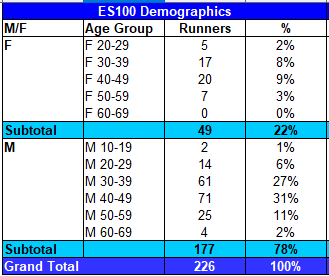
The age of runners this year is fairly consistent with prior years though skews a tad young for most 100 milers with only 16% over the age of 50. The M40-49 age group is the largest, which I’ve noticed is typically the case for all ultras (gotta love those mid-life crises). It’s nice to see almost 50 women signed up for the race, which is a relatively large number. The 22% compares to 13% in 2017 and 16% for MMT100 that I raced earlier this year.
And while not something I’ve looked at in the past, there will be a good international flavor to the race this year with 11 runners from Canada, 10 from Japan, and one from Sweden. Hopefully, we can show them a US that’s different than the ones they (and we) read about each day.
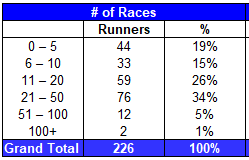
All of the data I get on the participant race history is sourced from UltraSignup. So while the data is good for US ultra trail racing (all my results are there), it’s not all encompassing as it excludes most international races, many sub-ultra only races, and anything that touches a road. Eight of the 226 entrants had no history at all, when they’ve obviously had to complete at least a 50 miler to get into ES100. That said, I believe these numbers give a fairly accurate description of the general experience level of runners.
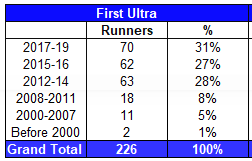
This is a typical spread of ultra experience. When you move up to the distance you automatically assume that everyone is a 10 year vet, when in reality the length of an ultra career is only 3-5 years. I don’t know if this is because of injury, burnout, or life but these numbers haven’t changed much in the couple years that I’ve been randomly looking at this. I’ve now reached the upper end of this range and while I hope I have another 20 years left in this sport, the future is promised to no one.

It always strikes me as odd that this race attracts so many runners that are relatively new to the 100 mile distance. It must be because this is becoming a bucket list type race as it sure isn’t because it’s an entry level course. I have mad respect for the 98 runners who hope to get their first buckle this weekend. I have two pieces of advice for the inexperienced. First is don’t decide to drop in between aid stations. This is because you can never mentally reverse course once you go there. The second is don’t think past the next aid station as the time left will seem incomprehensible to you. If you stay in the moment and keep problem solving, you’ll eventually baby step your way back to Little Pine State Park.
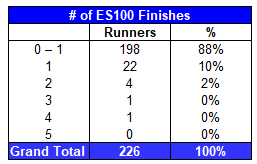
Here’s a fun fact. In 2017, you were more likely to finish the race if you had never earned an ES100 buckle (60%) than if you had already claimed one in a prior year (56%). Experience is a wonderful thing, but it’s not everything. Sometimes already reaching the mountain top will reduce your level of commitment and motivation (been there, done that). This is not a race you can afford to take for granted for even a minute.
Goals and Expectations
So obviously, my confidence level is really high coming into this year’s race. I’ve had a good first half of training (10% more miles than any other year) and racing, including a 31 hour finish at MMT100 in May in ridiculously hot weather. My body feels good, I have a good plan to attack the race based on my prior 2 finishes, and it now looks like the weather will be mild on Saturday. Everything is starting to fall into place.
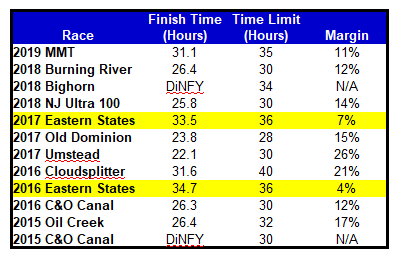
And just when my level of confidence was starting to move from the “good” to “over” category, I stumbled across this statistic: finishing margin relative to cutoffs.
Excluding my DiNFYs, I typically finish about 14% inside the final cutoff or about 26 hours for a 30 hour race. Only twice before have I ever been inside 10% and both those races were at Eastern States. I might very well be in the best 100 mile shape of my life and still not be able to get it done as this race provides no margin for error.
So while I would love to set a new PR in the low 30 hour range, a better goal for me is to just take what comes and enjoy my time out on the course.
